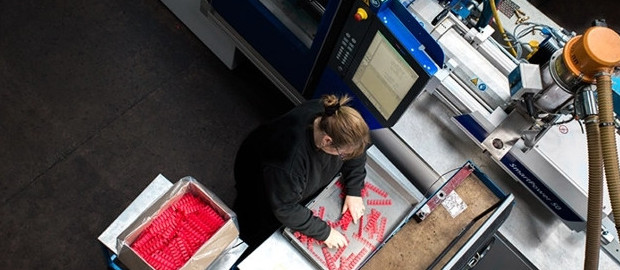
We work in partnership with customers from all sectors and all sizes. One of our more recent customers is FreshCheck, an Imperial College London startup. Their journey was reported on the Imperial College London website where you can read the article in full. This synopsis outlines how science meets manufacturing.
The science behind Imperial startup FreshCheck is elegant and deceptively simple: a dye that changes colour in the presence of bacteria. When the company was founded in 2015 it had several commercial applications in mind, from hygiene testing to healthcare. Yet its journey to the market has not been straightforward, with pivots and adjustments along the way to accommodate customer feedback and the COVID-19 pandemic.
FreshCheck was founded by Dr John Simpson and Alex Bond to commercialise work they did while undertaking their PhD research, carried out in the Institute of Chemical Biology. Their first idea was to put the bacteria-detecting dye into a food label, which would then change colour when the product inside the packaging was unsafe to eat. The labels worked, but the profit margin was so thin that they were not commercially viable.
So the company pivoted to address hygiene in the food preparation sector, settling on a spray as the simplest way of delivering the indicator liquid to the surface to be checked. Tested and launched in 2019, the product found some customers but did not take off in the way FreshCheck had hoped.
With COVID-19 raising the profile of surface hygiene, FreshCheck completed a £625,000 seed round in 2021 to develop the new swab and bring it to the market. This included a £250,000 contribution from the Imperial College Innovation Fund, which invests in startups with a strong connection to the College.
FreshCheck’s skills are in chemical engineering, so in order to perfect the swab the company sought out expert collaborators to help with the design. Supported by a £15,000 Innovate UK grant, it worked with the Manufacturing Technology Centre to perfect the two-tube arrangement that would make it easy to bring the swab and the colour-change liquid together.
Then Rutland Plastics took up the baton. “We worked with them to refine everything,” Mr Bond says. “The difference between a cap that is easy to put on or hard to take off requires fractions of millimetres to be shaved off or added.” The result is a swab that is cost-effective to produce at the scale FreshCheck requires to enter the market.
This whole process was informed by market testing. “We worked extensively with some of the top ten food manufacturers, to make sure our swab would work as a replacement for existing products,” Dr Bond says. “But we also worked with smaller companies, such as a pizza restaurant in London, to make sure it would be of interest to people not working with the existing technology."
Rutland Plastics has always worked in partnership with customers and this is a great example of how we used our expertise and experience to improve a customer's already brilliant product through the design for manufacturing process, when science meets manufacturing.
RECENT POSTS
Free design guide

"*" indicates required fields







